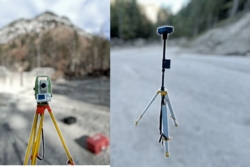
STREAM MONITORING / FIELD MEASUREMENTS
Successful river monitoring relies on the use of innovative methods and integrative approaches. At the Institute for Hydraulic Engineering, and River Research (IWA), field measurements have a long tradition, leading to the development of globally unique methods and insights into the processes of rivers.
A variety of measurement techniques are employed in river monitoring to gain critical knowledge about processes in rivers and their surroundings that are relevant to many research questions. Depending on the objective, the instruments are used either individually or in combination.
Point-based devices, such as the mobile bedload sampler or the so-called “Ray”, developed at IWA for measuring bed shear stress, provide snapshot results and can be flexibly deployed at different locations. In contrast, permanently installed instruments, such as geophones for measuring bedload transport intensity or turbidity sensors for suspended sediment monitoring, enable continuous and automated process monitoring. These devices provide valuable long-term data on key parameters.
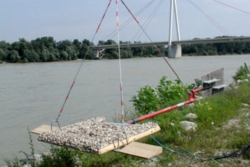
Hydrodynamic Parameters
Hydrodynamic parameters such as flow velocity and discharge are measured at the IWA using established instruments like the ADCP (Acoustic Doppler Current Profiler), ADV (Acoustic Doppler Velocimeter), and the Flow Tracker.
For measuring bed shear stress, IWA has developed an innovative device called the “Ray.” This device uses load cells to directly measure the forces acting on the riverbed, providing precise and reliable data on bed shear stress.
Suspended Sediment Transport – Innovation Through the Combination of Direct and Indirect Measurements
The monitoring of suspended sediment transport has been significantly advanced through the innovative combination of direct and indirect measurement methods. Direct methods, such as sediment sampling using scooping containers, isokinetic samplers, or automated pump samplers, provide precise, localized data on suspended sediment concentrations.
Indirect methods, on the other hand, rely on proxy measurements, such as turbidity sensors or acoustic backscatter data from instruments like the ADCP (Acoustic Doppler Current Profiler), to infer sediment concentrations. Optical probes, for example, offer continuous turbidity measurements, while acoustic methods can provide insights into sediment distribution across a river cross-section.
By integrating these methods, researchers can leverage the strengths of both approaches. Direct measurements provide calibration and validation for the indirect methods, while indirect methods enable continuous and spatially extensive data collection. This combination allows for a comprehensive understanding of both the temporal and spatial variability of suspended sediment transport.
Such an approach not only improves the accuracy of sediment load calculations but also supports advanced applications, such as tracking sediment plumes from dredging activities, assessing changes during reservoir drawdowns, and calculating sediment budgets for specific river sections. This integration of methods represents a significant step forward in sediment transport research and monitoring.
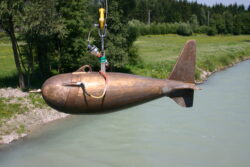
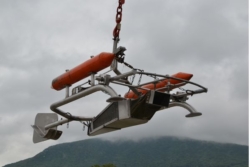
Bedload Transport – Mobile Bedload Sampler
Mobile bedload samplers are deployed on the riverbed to capture transported bedload using a suitable container over a defined measurement period. Their range of application includes steep mountain streams with high flow velocities and large grain sizes, as well as wide and deep gravel-bed rivers with finer bedload grain sizes.
The varying hydrodynamic conditions and local circumstances require adjustments to the measurement methods. At IWA, different types of bedload samplers are used to reliably capture transport processes under diverse conditions. This allows for precise investigations of turbulent mountain rivers, such as the Rofenache at an elevation of 1,980 meters, as well as high-flow events up to HQ200 (200-year flood) on the Danube.
These adaptable tools provide valuable data for understanding bedload transport dynamics across a wide range of environments.
Bedload Transport – Bedload Trap
The bedload trap enables automated and long-term monitoring of bedload transport across the entire flow spectrum. The device consists of a collection container mounted on load cells and embedded in the riverbed. The container’s cover can be hydraulically opened, allowing bedload material to fall through a measurement slot into the collection box, where it is continuously and automatically weighed.
After a successful measurement, the bedload trap must be maintained during low-flow conditions. A special design is the liftable trap on the Drau River in Dellach. This trap is height-adjustable via a hydraulic mechanism, allowing it to be accessed and maintained even during higher water levels.
This innovative system provides precise and continuous data on bedload transport, making it a valuable tool for understanding sediment dynamics in rivers.
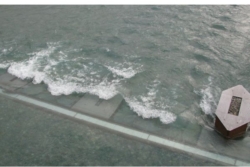
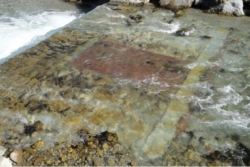
Bedload Transport – Geophone System
Geophones are vibration sensors originally developed for seismic applications. For bedload measurement, they are mounted on the underside of steel plates, which are installed at the riverbed level and distributed across the entire flow cross-section. When bedload material is transported over the steel plates, it generates vibrations that are detected by the geophones and automatically recorded continuously (indirect bedload measurement).
The geophone system provides high-resolution temporal and spatial data on the bedload transport process. To convert the recorded data into bedload transport rates or loads, the indirect measurements must be calibrated using direct methods, such as bedload samplers or bedload traps.
This system is a powerful tool for monitoring sediment transport dynamics, offering continuous insights into bedload movement across various flow conditions.
Bedload Transport – Integrative Bedload Measurement System
Bedload transport is a highly variable process in both space and time. Existing measurement methods each have their specific strengths but are unable to fully capture the bedload transport process on their own.
At the IWA, the integrated bedload measurement system is employed, which combines various measurement methods. By integrating direct methods (e.g., bedload samplers and traps) with indirect methods (e.g., geophone systems), this approach allows for the collection of high-quality and comprehensive data.
The combination of these methods provides a more complete understanding of bedload transport dynamics, enabling the analysis of both temporal and spatial variability with greater accuracy and reliability. This integrative approach is essential for advancing research and management of sediment transport in rivers.
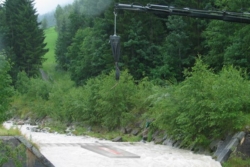
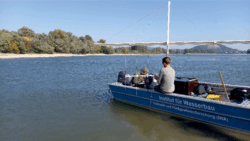
Bedload Transport – Tracer
Radiotracers enable the measurement of transport distances, velocities, and movement paths of individual sediment particles (tracer stones). Either natural river sediments or artificially created tracers are used for this purpose. At the IWA, both active and passive tracers are employed. Both systems allow for the unique identification of tracer stones, enabling their targeted recovery and the tracking of their movements. A typical tracer measurement system consists of a transmitter (“transponder” or “tag”) embedded in the stones, a reader to capture the tag information, and an antenna for signal transmission.
Active transponders offer the significant advantage of a large detection range of approximately 120 meters. However, since they are powered by an internal battery, they are relatively large, and their lifespan is limited to 1 to 5 years. This technology is primarily used at IWA in larger rivers such as the Danube, Drau, Gail, and Rhine. Passive transponders, on the other hand, are characterized by their small size and long lifespan (up to 10 years). As they lack an internal power source, they must first be inductively charged via the antenna for communication, resulting in a limited detection range of about one meter. At IWA, this technology is mainly used in smaller rivers such as the Urslau, Strobler Weissenbach, and Alm, as well as in side channels of larger rivers like the Inn or Rhine.
By employing these technologies, the IWA can effectively monitor sediment transport processes across a wide range of river systems, adapting the choice of tracer type to the specific conditions and requirements of each study.
Riverbed Substrate – Freeze Core Sampling
In addition to common methods for grain size analysis, such as collecting volumetric samples, performing Wolman counts, or conducting line-intercept analyses, the IWA, in collaboration with the company UWITEC, also utilizes freeze-core sampling techniques.
In freeze-core sampling, a metal tube is driven 0.5 to 1 meter deep into the riverbed. The tube is then cooled to -196 °C using liquid nitrogen, causing the riverbed substrate to freeze onto the outside of the tube. This process takes between 20 and 45 minutes, depending on the water temperature. Once the freezing is complete, the tube is extracted from the riverbed, and the sample can be divided into relevant layers either onshore or aboard a vessel.
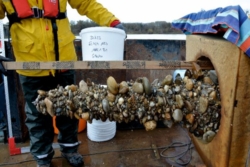
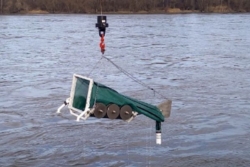
Monitoring Micro- and Macroplastic Transport
Plastic pollution has become ubiquitous in our environment. Research in recent years has shown that plastic can be found even in the most remote areas of the planet. Rivers are both major pathways for plastic entering the oceans and directly affected by pollution themselves. However, there are currently few standards or guidelines for measuring plastic transport in rivers. Such standards are essential to make globally collected data comparable and to create shared databases.
IWA has made significant contributions to research on both microplastic and macroplastic transport. For microplastics, IWA is developing isokinetic methods to measure plastic transport in rivers. These methods combine net sampling at multiple depths with pump-based sampling. While the nets filter out coarser microplastic particles, the pump filters capture the finest particles down to a size of 25 µm.
For macroplastics, the IWA employs GPS tracers as a monitoring method and uses hydrodynamic-numerical models to better understand transport processes and extrapolate them to larger scales. These approaches provide valuable insights into the dynamics of plastic pollution in rivers and contribute to the development of standardized measurement techniques.
Morphological Monitoring – GNSS Systems
At IWA, total stations and GNSS systems are used complementarily to perform precise and flexible surveys. Drones equipped with photogrammetry and LiDAR technology further enable the creation of versatile 3D models. The accuracy of these surveys is enhanced through the use of control points, stationary GNSS antennas, and real-time correction data.
The drones employed range from compact camera models to multicopters equipped with LiDAR sensors capable of capturing tens of thousands of points per second. These technologies are applied not only in the analysis of river morphology but also in the monitoring of bedload retention structures. In these applications, cameras and LiDAR sensors continuously measure the fill levels of retention basins.
